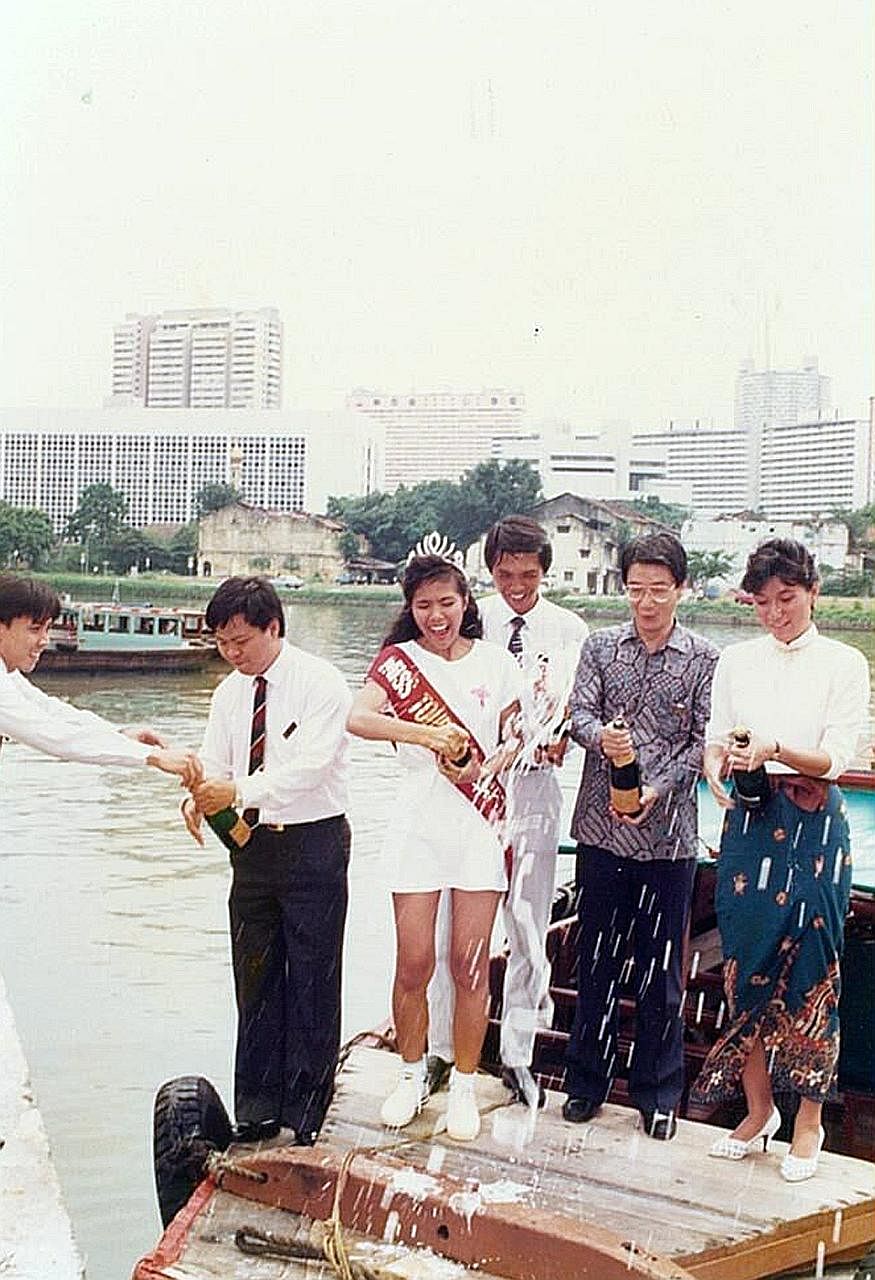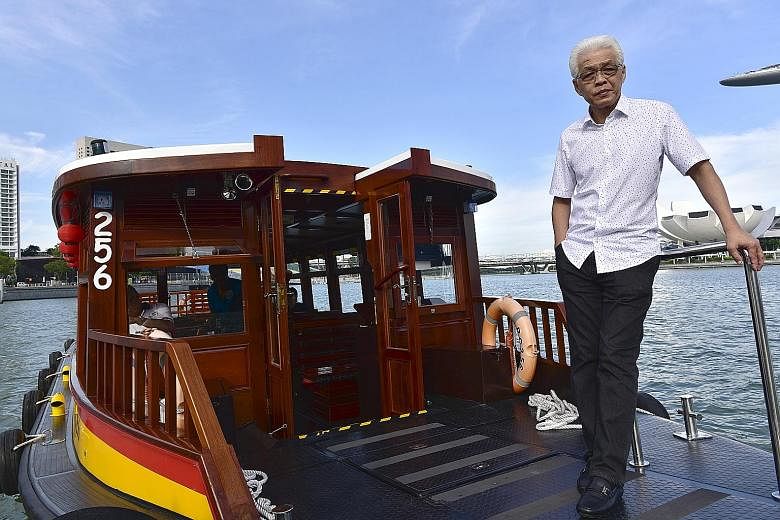About 40 years ago, Png Yiow Beng asked his father to lend him $25,000 so that he could buy a passenger launch to ferry people up and down the Singapore River.
His father, a bumboat operator, said no because he felt the boat, which had a 74kW motor, guzzled fuel and was not a good investment.
Then, in his early 20s, Mr Png was not deterred. He turned to his neighbour and a relative instead.
He tightened his belt, survived on bread and started slogging. Within six months, he paid off what he borrowed.
Mr Png, now 62, has not looked back since. Today, the founder of Singapore River Cruise and Trishaw Uncle owns a fleet of 25 electric bumboats and 100 trishaws which ferry tourists daily around interesting areas in downtown Singapore.
"My whole life has revolved around the Singapore River," he says in Mandarin in his High Street Centre office, which offers a commanding view of Boat Quay.
"My father came to Singapore from Jinmen when he was 26," he says referring to an island opposite Xiamen, China. "He married my mother, originally from Indonesia, a few years later. He rowed sampans before he got himself a lighter."
The second of seven children and the eldest son, Mr Png spent his early years in Cecil Street.
The family lived in one of seven cubicles in a shophouse which accommodated about 40 people.
"There was space for just one bed in our cubicle, so all the children slept on the floor. There was only one common toilet outside and my mother used to say that she had to be careful not to trample on her children if she wanted to answer the call of nature at night," he says with a hearty laugh.
He adds: "I don't know how 40 people coped with just one common toilet, but we did. My wife and I fight even though we have one bathroom to ourselves today."
His neighbours were a motley and colourful lot. They included a teacher, a bar girl, an illegal bookie, a hawker and even a man who ran a children's publication from his cubicle.

In those days, bumboats, barges, tongkangs and other sea vessels plied the Singapore River.
The surrounding areas were dotted with godowns, warehouses and offices around which activities and businesses - both legitimate and unsavoury - sprung.
"There were dead dogs and cats in the river. I once saw a corpse too," he says.
As a child, he would tag along with his father who carried both goods and passengers in his bumboat. "He'd tie a rope around our waists and we would jump into the river to swim. Sometimes, I'd spend the night on the boat to guard goods he carried," Mr Png recalls.
He loved waking up on the boat to the sights and sounds on the river.
"I wanted to work on the river too. I knew it would be a hard life but perhaps it's in my blood. My father did not object to what we did as long as it wasn't stealing or robbing," says Mr Png, who attended Chongfu Primary and Bukit Ho Swee Secondary schools.
He got his boating licence at 18, after completing his secondary school education.
"In those days, the police were really after those who drove boats without licences. A friend who ran a boating business asked me to help. I operated a bumboat for him for a while."
Eager to strike out on his own, he decided to invest in a passenger launch which could carry 12 people. When his father turned him down, he dug into his own savings and turned to a neighbour.
"He was a coolie but I heard he had a hotel in Penang. He lent me $10,000; I promised to return it within a year. To save money, I ate bread every day. But I paid him back within half a year," says Mr Png.
There was no lack of work for the enterprising and energetic young man.
He worked long hours, ferrying people and goods, earning a few thousand dollars a month.
"Because money was easy to come by, a lot of people frittered it away at the bars," he says, referring to the many watering holes and sleazy attractions around Collyer Quay and the surrounding areas. "I realised that, so after I finished work each day, I'd leave the harbour."
Life as a boat operator, he says, required skilful navigating.
There were gangsters out for protection money and unscrupulous competitors who undercut each other.
"The trade was not regulated, and the whole area was complicated," says Mr Png, who married his secondary school sweetheart in 1981.
Fortunately, he was blessed not just with street smarts but derring-do as well. Steadily, his business grew, and he acquired more boats. One of the biggest contracts he secured was China Ocean Shipping Company, which had 100 of its vessels sailing each month into Singapore.
But like all the denizens who lived or worked around the river, his life took a different turn because of the Singapore River cleanup under the orders of founding prime minister Lee Kuan Yew in 1977.
Over the decades, the squatters, hawkers and industries crowding the banks had led to severe pollution.
The exercise took 10 years and cost $170 million. Hundreds of bumboats ferrying goods from warehouses along the river to cargo ships out at sea were moved to a new lighter anchorage at Pasir Panjang. Squatters were relocated, hawkers moved to hawker centres.
Mr Png remembers feeling a sense of loss.
"I'd spent my life by the river and I thought it had so much life. I hadn't travelled much in those days but I remember thinking to myself: 'Singapore doesn't have an Eiffel Tower but there probably aren't many places which have hundreds and hundreds of bumboats on the waters'," he says.
Many boat operators decided to call it a day.
"They didn't know what the future held," he says.
He soldiered on because he operated out of Clifford Pier, which was not affected. In 2006, he moved his operations - now managed by his only son - to Marina South Pier.
In 1987, he bid for a tender by the Singapore Tourism Board (STB) to operate a cruise service along the cleaned-up Singapore River.
He recalls with a grin: "Of the companies which responded, mine was the smallest. They all had thick proposals. I wrote mine on two pieces of foolscap paper. Some of the other companies told me: 'Eh never mind lah. If we get, we will sub-contract to you'."
To his surprise, he was shortlisted.
"An STB officer handed me a letter which said I was shortlisted but said his boss asked why my proposal was so thin. I told him I didn't know much about proposals but I knew a lot about boats and the river. I said I could do whatever they needed. I also said they could test me out."
Serendipity helped him when he was hired to ferry international contestants for the Miss Universe pageant held in Singapore that year. "The contestants were to be dropped off at (the now-defunct) Warehouse Disco. So, at a meeting, I said they shouldn't wear outfits that were too tight or heels that were too high," he says.
A Miss Universe official put his foot down.
"He said when Miss Universe contestants went out, they had to look their best and most glamorous. So an STB official asked me if I could do it. He said it would be bad if Miss America fell or Miss Germany got a bump on her head on my boat."
Mr Png set to work, retrofitting his vessel to minimise mishaps, taking note of tide times to avoid waves and bumpiness.
"Everything went well," says Mr Png who started Lian Hup Choon Marine, later renamed Singapore River Cruise, after being awarded the tender together with Hotel New Otani.
He invested in four bumboats, each costing him $40,000.
Business was slow in the beginning. But he was optimistic: He felt that the $5 fare was small change to the tourists they were hoping to attract.
Today, he charges $25. His fleet has grown to 25.
"We have also moved with the times. We cannot pollute the waters because the Marina Barrage is also a reservoir, so the bumboats have also been retrofitted with electric zero-emission engines," he says.
The opening of Marina Bay Sands and the development of Singapore's waterfront have been good to him and the resulting increase in tourist arrivals has been good for his business.
When STB put out a tender for a trishaw tour service seven years ago, he put his hat in the ring too and started Trishaw Uncle.
Trishaw riders were a common sight in his childhood, he says, and he could identify with these blue-collar workers because he came from a humble background himself.
"They're an important part of Singapore's heritage... I hope to be able to contribute my knowledge and insights to grow the trishaw industry and show trishaw riders that there is a future for them and room for growth in the tourism business."
Proudly, he says that all the 60 riders he employs are Singaporean. The youngest is 27.
All the trishaws are equipped with GPS features which will trigger commentaries at popular tourist attractions. The company recently launched new routes connecting Singapore's heritage districts, and also linked up with sister company Singapore River Cruise to offer a trishaw/bumboat combo ride.
Mr Png is also the biggest shareholder of the company that runs Chinatown Heritage Centre in Pagoda Street.
Located in a shophouse, the centre recreates the original interiors of the 1950s, offering glimpses into the lives of Chinatown's early residents.
With a wistful smile, the grandfather of two toddlers says that the Singapore River will always hold a special place in his heart.
It is not only inextricably linked to his life, he says looking at the view from his office window, "it is also where Singapore's development first started. It is where we can see the past, present and future of Singapore".
Correction note: An earlier version of this story said Mr Png's father came to Singapore from Jingmen in Hubei province. It should be Jinmen, an island opposite Xiamen. We are sorry for the error.


